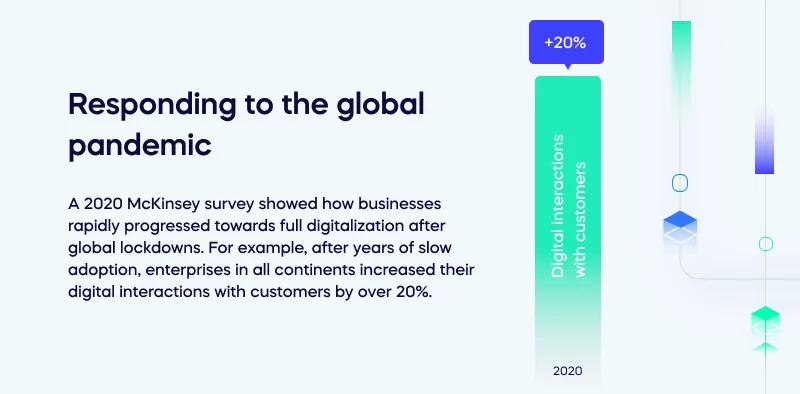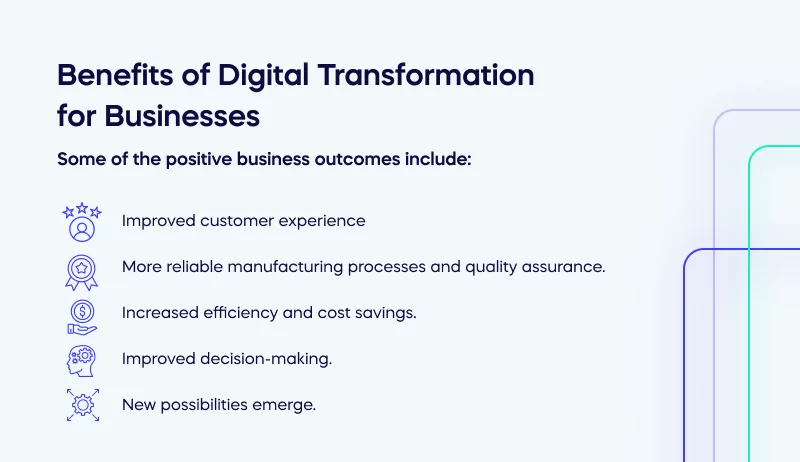The reasons why businesses are experiencing a digital transformation are not complicated. Put simply, digital technologies have a proven track record of delivering results; change managers now have effective digital transformation strategies at their disposal; and when older companies don’t make digital technology part of their business strategy, new companies quickly disrupt the market.
However, there are complex areas of business expertise and specialist knowledge behind these simple reasons. This article will explain why major business models are adopting digital tools more quickly than ever. It will cover specific technologies, including automation, data analytics, artificial intelligence, and more.
It will also explain the implications of these new technologies on workflow, efficiency, automation, and big data.
Why Are Businesses Experiencing Digital Transformation?
The digital revolution has been a major driver of digital transformation. However, the rollout of digital solutions has been massively accelerated thanks to the global pandemic.
On the one hand, digital technologies such as automation, analytics, and artificial intelligence (AI) are now accessible to businesses of all sizes. Digital tools have become an essential to the modern business world, transforming how companies operate, communicate, and compete in the marketplace.
But on the other hand, when Covid-19 forced millions of global workers into lockdown, businesses had no option. They had to adopt whatever digital strategies they could to continue productivity.
This section will analyze some of the major drivers of digital transformation in the early 2020s.
Responding to the global pandemic
Many key digital technologies for efficient business processes existed before 2020. But it took Covid-19 to push them to the front of contemporary business models. In a world where people couldn’t work in the same space, interact with strangers, or travel to business meetings, digital transformation offered the only way for organizations to keep doing what they needed.
A 2020 McKinsey survey showed how businesses rapidly progressed towards full digitalization after global lockdowns. For example, after years of slow adoption, enterprises in all continents increased their digital interactions with customers by over 20%.
Suddenly, the business priorities changed. And even though the risks of the pandemic have now reduced significantly, the changes in working practices are here to stay.
Legacy modernization
Legacy technology systems might have been “good enough” for years. But with the innovations of cloud computing, enhanced UX design, and advanced monitoring systems, technology has become highly accessible. Technology has advanced capabilities that anyone can harness.
However, new solutions do not always operate well with legacy systems. And aside from compatibility, finding staff to support older systems is becoming challenging. And as digital systems change, it has become more and more difficult for businesses to keep up with the necessary talent and support needs.
A recent Deloitte report suggested that companies can no longer find staff to code in COBOL and Natural.
The pace of technological change means that forward-facing companies just cannot rely on their older systems. They must keep up with the changes to improve business outcomes through digital solutions.
Frontline service/supply chain
Digital transformation is radically changing supply chain management.
Some years ago, McKinsey reported that only a few managers were interested in digitizing supply chains. At the same time – they said that supply chain digitization could bring significant efficiencies.
There are many opportunities for digital transformation in complex logistics operations. Leadership can keep a closer on inventory management in a warehouse and monitor dispatches at every stage of the fulfillment journey. AI can quickly trace problems in a complex system and plan effectively. Integrated datasets can improve planning dramatically.
However, the challenges are also significant. Like any digital implementation project, logistics managers must ensure that software, hardware, business processes, and staff expertise connect. But when supply chains cross many different business units in a complex company, every one of these challenges is doubled.
Simplifying Cross-functional teams with Digital Transformation
A cross-functional team can solve complex problems from start to finish. As a BCG blog post explains, “they are experimental but rigorous in tracking results, and they are persistent.”
Digital transformation makes a big difference to the Agile work of cross-functional teams. With the help of cloud computing and other digital technologies, businesses can improve their ability to process, store and analyze data. Simple applications help to connect projects, schedules, and workloads, thereby creating corporate and individual workloads that are efficient and effective.
In place of awkward manual processes, new technology can enable businesses to break down data silos and encourage collaboration, leading to a more efficient and effective organization. Clear, automized workflows can be the foundation of informed decisions, excellent customer service, and overall business success.
Benefits of Digital Transformation for Businesses
The digital transformation process is not easy for older businesses – but it is well worth the trouble. Some of the positive business outcomes include:
-
Improved customer experience. Businesses can create more personalized customer experiences using digital technology to engage with modern consumer behavior. This ultimately leads to higher customer satisfaction and loyalty.
-
More reliable manufacturing processes and quality assurance.
-
Increased efficiency and cost savings. Digital tools are now available that help automate business processes, lowering costs while increasing efficiency and speed. This can result in a significant competitive advantage.
-
Improved decision-making. Digital intelligence solutions enable businesses to collect and analyze data quickly and accurately, allowing them to make business decisions faster than ever before.
-
New possibilities emerge. Digital transformation opens up new business possibilities, such as reaching a larger audience, offering new services, and re-deploying staff.
Future-proof your Business with Digital Technology
Digital transformations go far beyond simply adopting digital tools. It involves a complete rethinking of business processes, products, and services. In many sectors, businesses that don’t take a proactive interest in digital transformation will fail. Today, companies must experience digital transformation simply to survive.
Every industry has its own specific drivers of digital transformation, and the implementation of new technologies is different in every part of the world. Nonetheless, this article has described the main reasons businesses are experiencing a digital transformation.
While the pandemic has forced businesses to think differently about their models, digital technology offers solutions to many problems modern organizations face. We now face a “new normal” in which technology is essential for any sustainable business.





